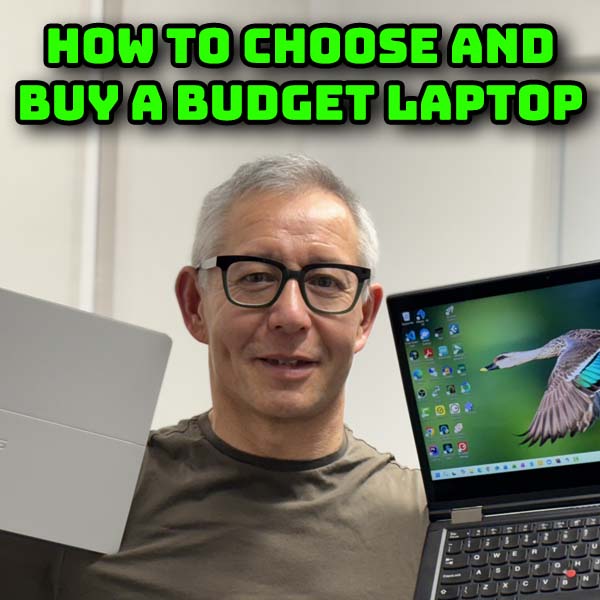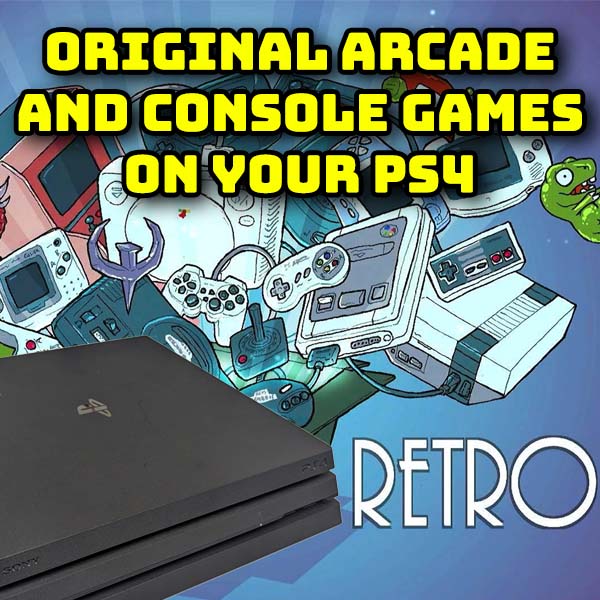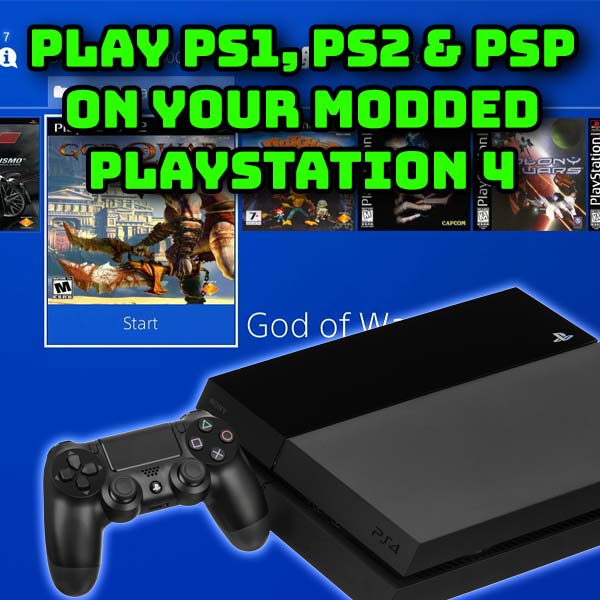
Play real arcade and console games on the PS4 with RetroArch – Full installation and setup
17th November 2025How to buy a laptop on a budget – get the right computer for school, college or university
Laptops are an essential tool for students whether you’re at school, college or University. But there are so many options and prices that it can be very confusing trying to work out what’s the best fit for you. It’s also a big outlay of cash so you really want to get it right without spending over the odds for what you want.
So in this video I’ll walk you through the jargon and endless specifications to get right down to the essentials you need to cover.
These tips will also work for desktop PCs, but there you’ll also need to consider what type of screen to buy and usually what type of graphics cards and other expansions, so a few more options.
So let’s get started.
What Are You Going to Use It For?
The first stage of choosing a laptop is to work out what you’re going to be using it for. Pretty much every other decision follows on from this.
There are a number of basic tasks that almost every student will want to do. Word processing, browsing the Internet and email handling all fall into this base functionality you need. Maybe you’ll need to be able to use spreadsheets, create a presentation or other office like tasks.
These sorts of tasks don’t put a lot of pressure on the laptop. Mostly the computer will be sitting waiting for you to do something like pressing a key or clicking a button. This means that they don’t require a powerful and expensive machine.
But there might be other applications that you need to be able to run.
Perhaps you’ll need to be able to edit photographs or create artwork. Your course might involve some video creation and editing. Maybe you’ll be producing music and want to digitally edit your sound. You might want to stream videos from online services or maybe you’ll be creating 3D models and running engineering simulations.
Any applications that involve processing lots of data whether it’s images, video or simulations will need a more powerful computer. These applications will still run on less powerful machines but they will be slower and can leave you sitting waiting for tasks to complete.
At this point we should mention gaming. If you want to use this laptop for PC gaming then you’re going to quickly push up the specification and price. Games are usually the most machine intensive task you can run on your laptop. Most laptops will make an attempt at your favourite games, but unless you want to pay out for specialist hardware options you’ll not be able to run modern games at full speed or high quality. In this video I’m going to assume you’re not looking for a gaming machine.
So do be honest with yourself and draw up a list of the applications and tasks you need to use the laptop for. Armed with this we can start to work out what we need to buy.
AI Laptops
At this point it’s probably worth mentioning AI laptops which seem to be the headline feature at the moment. This is a new development over the last year or so and is being sold as the revolutionary new way of powering a computer.
To be honest I think it’s currently more hype than substance. These computers have a dedicated chip inside that’s specialised in running AI applications. This can help in certain situations but software is still not making much use of it. Pretty much everything an AI laptop can do a normal one can do as well using online AI services. These may run slightly slower but I think you’d be hard pressed to notice too much of a difference.
Over the next 5 years this integrated AI will probably get better and more useful but by then you’ll be looking to upgrade your laptop anyway.
So unless you’re happy paying the premium for the AI chip I’d not worry too much about it.
What Do The Specifications Mean
When you’re looking for any computer you’ll have endless jargon and a range of numbers being thrown at you. An awful lot of it is sales talk but there are some basic features that you need to pay attention to.
I’ll talk you through the main points here so you have an understanding of what they mean, but after this we’ll look at some easier ways to work out if a computer is right for you.
Size
It sounds obvious but laptops come in different sizes. The standard size tends to be around 15 inches. This size measures the diagonal dimension of the laptop screen, in much that same way that a TV screen size is measured. You can get bigger and smaller laptops so bear in mind what you want to do with the machine. If you’ll need to look at fine detail or will need lots of information on screen don’t buy a very small laptop. Alternatively if you need to use it on the move a big laptop can be awkward.
Screen Resolution
Screens are also measured in pixels which are the individual dots used to make up the screen image you see. The more pixels your screen has the more detail and smoother your screen display will look. Most laptops will have a full HD, also known as 1080p, screen resolution which is 1920 pixels wide and 1080 pixels tall. For most of us this is more than adequate.
2K, 1440p and 4K screens offer much better displays but on a small laptop sized screen you’ll not really get the full benefit of these better resolutions.
The screen refresh rate tells you how many times it gets redrawn per second. The standard 60 Hz is fine for most tasks. Higher refresh rates are great for gaming but in almost all other applications you won’t notice the difference. Higher refresh rates give you smoother animation playback but again this might not be significant to the applications you run.
Again gaming tends to get the most benefit from these more expensive displays.
Processors
We’re now getting to the big factors in the performance and usability of your laptop.
The main processor probably has the biggest impact. This is the actual brains of your laptop. Here you will really start to get bombarded with technical details.
These days processors are built from a number of smaller processors or cores. These cores can split the workload to either run more tasks simultaneously or speed up very intensive operations. Generally more cores are better.
Processors run at a certain clock speed, which basically tells you how many operations it can perform per second. This is the GHz figure you’ll see. Generally the higher the processor clock speed the faster it can run tasks.
Laptops need to be able to run from a battery and the processor is probably the component that uses the most power. So you’ll find a wattage or TDP figure attached to the processor. The more watts the faster it will use up the battery.
There are a lot of options on processors so we’ll talk about an easier way to choose what you need in a bit.
Memory
For the processor to work you need memory or RAM. This is where the computer stores the information that it’s working on. The amount you need will depend on the task you are running and the number of tasks you’re running at the same time.
For example if you are editing an image with multiple layers of high resolution photos the computer needs a lot of memory to be able to store the image data. If it can fit this data into RAM you’ll be able to process the image quickly. If it doesn’t fit into RAM the computer will store some data on its hard drive and swap it in and out of RAM making operations a lot slower.
RAM is measured in Giga bytes. As a base guide 4GB is an absolute minimum, 8GB is fine, 16GB is great, more will only make a difference if you are running very data intensive applications.
Storage
As you work on your computer you’ll need to save your documents and projects. For this the laptop will need a hard drive. These are digital storage devices that can store large amounts of data. Again they are measured in GB with 250GB being the minimum size you’ll find on most machines.
If you are mostly storing written work, spreadsheets and a few presentations on your computer 250GB will be fine. If you’ll be photo editing or running engineering applications you’ll probably need 500GB or more. For video production you’ll want at least 1TB or 1000GB.
Hard drives also come in 3 main varieties.
The old style mechanical drives haven’t been used for quite a few years as they are slow and use more battery power. For a laptop I’d probably avoid them.
Solid State Drives or SDDs provide a good mix of speed, storage space and price. They work about 10 times faster than mechanical drives and are perfect for most users.
More recent laptops will use NVMe drives that are about 10 times faster than SSD drives meaning that your files will open and save much faster. These are especially useful if you are pulling lots of data from storage in tasks like video editing or music production.
Working Out Which One To Buy
We’ve now looked at the main factors you need to consider. So how do we get to a final laptop spec that will work for you?
Operating System
The first decision I’d advise you make is on your operating system. This is basically the type of computer you want to use. By this I mean do you want an Apple laptop, a Windows powered computer, maybe Linux or even a Chromebook.
Partly this will be dictated by the applications you want to run. For example, if you need a piece of software that only runs on an Apple computer then your hands are tied.
You might also need to be compatible with other users or certain work requirements. If your computer runs a different operating system to what is expected this can cause problems.
Having said that most laptops can run the same, or compatible applications. Sharing data is usually not an issue, even if you have to go through a few more steps to match in with other people. If you’re in doubt ask friends or staff for some advice.
If there are no restrictions on what to use then it will be down to your preference.
If you are an Apple person your choices will become quite simple in terms of the range you are choosing from. You just need to work out which one gives you the best price for performance.
If you’re looking at a Linux laptop you’ll probably know more about how to choose than we’ll be covering in this video.
Chromebooks are a fairly restricted type of computer. If you’re using it solely for office based tasks like word processing and general Internet usage they can be OK. But if you need to run any other applications they may not work.
This then leaves Windows which is the option that works for most people. I’d advise that unless you have a reason not to choose Windows, choose Windows.
Choosing Your Spec
We covered the ideas on laptop size, storage and RAM earlier. These options are really where you should get the best setup you can in your budget.
But the processor choice is the one you’ll probably have the most trouble deciding on. There are so many options and they are all wrapped up in dense jargon. Processor choice basically boils down to choosing one that will run your applications smoothly and fast enough so you don’t get frustrated.
All processors built in the last 7 or 8 years will run all your software. They just might not run it very well.
Obsolete Hardware
First off you need to keep an eye on obsolescence. If you are going down the second hand route, this is where certain processors and hardware stop being supported. If you buy unsupported hardware you could find that you’re not able to run the software you want. There are often ways around this but unless you’re happy playing messing with your laptop setup you’re best avoiding this.
On the Apple side of things you’ll need to check their information about which models are no longer being supported. Apple makes its devices obsolete after about seven years. The computer will still work but you won’t get any software and security updates, and you will be blocked from upgrading it to the latest versions.
For Windows the only real constraint is if the laptop is Windows 11 compliant. The latest version of Windows requires your processor to have certain features. This is fine for most processors released after 2017. The official requirement is for an 8th generation Intel Core processor or a Ryzen series 2000 processor. All new computers will be compatible and will come with Windows 11 installed. If you go the second hand route you might get Windows 10. This is no longer supported by Microsoft so again you won’t get software and security updates but Windows 11 can be installed on most computers quite easily by bypassing the requirements.
Processor Performance
The big factor you need to get right is the processor performance. This is a combination of the processor model, the number of cores it has and the speed the cores run at. You can get ultra technical about this but my advice is to use a simple benchmark test.
Benchmarking is where people run processors to find out how well they perform in various tasks and then combine all that data into a single performance number. You can then use this number to compare processors and to work out which ones will run the tasks you want them to.
I know a lot of people will say, “but what about this and that”, and they are right, but benchmarks are a reliable measurement of general performance and make the whole process of getting a fast enough computer very easy.
The main website I use to compare processors is
This website has a lot of data on pretty much every processor ever made. And it lets you compare them side by side.
To use the benchmark figures you need some sort of baseline value to compare against. If you’ve already got a computer, or use one at school, or have a friend with one you can see how well that performs. You can then find out what processor and RAM it has. On a Windows computer go to the Windows menu and type system info into the search box. You should see the System Information app pop up. Run that.
You should now see a list of the computer specifications. Make a note of the Processor and Installed Physical Memory (RAM) values.
You can now go to the benchmark website and click on the compare icon in the top right hand corner. This will bring you to a page where you can start to add processors to the compare list. Type the processor number into the Add Other CPU box. As you type you should see it appear in the dropdown list. Make sure you chose the one that exactly matches the processor you’re looking for.
For example, my desktop computer processor was listed as an Intel Core i7-7700K CPU @4.2GHz. The processor number is the i7-7700K. As I type that in you’ll see it pop up in the list. Once you see the one you want, click on it and it will be added to the compare list.
For the compare list to work you need to add at least two CPUs. If you’ve got a second add that, or just add any other to get the data to display.
You can now click the compare button to see the performance figures.
In this table you’ll see all the figures we need for comparison.
The important ones are near the bottom. The CPU Mark is the overall score. The higher the number the better the faster the CPU will run your software. Usually this is all you need to compare. The single thread value is also important as it measures the processor speed for simpler applications, or parts of more complex operations. Just make sure that this is not vastly inferior.
Finally you’ll also get a TDP value which tells you how much power the processor is likely to use. Again it’s an approximate way to compare processors but will give you an idea of potential battery life.
Baseline CPU Mark Values
If you’re not sure what a baseline value should be here are some numbers I use.
For all the basic office, web and streaming video tasks my Lenovo laptop easily copes with everything with a CPU Mark of 6000. 5000 would most likely still be OK, but less than that and you’ll start to notice slight pauses as you work.
My desktop machine that I use to edit my videos and run 3D modelling software on has a CPU Mark of 10000. That’s just about OK for this work but it can lag slightly when running lots of effects in a video preview. These lags disappear when running on one of my newer mini PCs with a CPU Mark of 15000.
New or Second Hand
Finally you’ll need to consider if you want to buy new or second hand.
New, of course, has the advantage of coming fresh out of the box so it will be in perfect condition. No-one has had the chance to mess with the hardware or softweare and you get the reassurance of a guarantee if something goes wrong. But you will pay a premium price.
Second hand gives you access to potentially more powerful and higher specification computers for less money but you do need to be careful where, and from whom, you buy from.
There computer refurbishment companies like CEX and Back Market who check the computers over and will give you really good guarantees and these can be a great half way house between new and private sellers.
For private sellers on eBay and other websites, or even in person, you do need to get some sort of reassurance that you’re going to get what you order, and in the condition you’re being told. Make sure you have some sort of solution if the machine is not right when you receive it.
Overall I guess the choice will come down to your personal choice, but I do strongly advise you to look at the second hand market as you’ll find some really good deals out there. Especially over the next year or so from now, November 2025, as Windows 10 has just died and a lot of people and businesses will want to upgrade their laptops.
Even though these will not meet the Windows 11 specification they can easily be upgraded with very basic IT skills – downloading and copying files.
Upgrading Laptops
Sometimes you’ll find a computer that is almost exactly what you want but lacking in maybe one area. This is where you can consider buying and upgrading.
Again you’ll need to be comfortable opening up a laptop and swapping out some parts. If you’re not sure about this I’d probably try to buy what you want ready made, or get some quotes from an IT specialist. Upgrades are not hard to do but you can badly damage things if you don’t know what you’re doing.
For laptops you’ll only be able to upgrade the hard disk and possibly the RAM. Sometimes the RAM in laptops is soldered in so you can’t change it. Check the model you’re thinking of buying online to see what’s possible. You’ll also find tutorials on how to open your laptop. Some require the screen to be de glued and prised off. If you’re not familiar with how to do that I’d tend to avoid trying as it’s very easy to crack the screen. Believe me, I’ve done the experiment and paid the price.
But upgrading can get you your ideal spec from a close miss.
Overall Choices
So that’s the basic information on what you need to think about when choosing a laptop, or any PC.
As an example, here’s my thinking when I bought my ‘new’ laptop last year.
I needed a laptop for general office tasks, video streaming and some code development while out and about. I particularly wanted a computer that I could use for note taking directly onto the screen with a pen – great for meetings and lectures. That brought my choice down to tablet PCs and convertibles. I didn’t want to spend too much on the device as it’s really a secondary PC, but I did want it to be a good user experience in terms of performance.
My desktop machine at the time had a CPU Mark of around 5000 and was fine for those tasks so I knew I needed one at least as fast as that computer.
Looking at the new market, I was going to have to spend around £500 or over for a Windows machine, or about £300 for a Chromebook. Some of the cheaper machines did have a new generation processor but it was the reduced Intel N100 which has a CPU Mark of 5000. Good enough but I wanted a bit more for my money.
Looking at the second hand market opened up a range of options in the under £500 bracket. Most of these laptops were mid to premium spec machines when new a few years ago. So they were still powerful machines, just not the latest hardware.
For me this seemed like a great compromise between cost, current hardware and specification.
A bit of research on the second hand market narrowed my choice down to a few models including the Microsoft Surface, Lenovo ThinkPad and some Dell Convertibles. These tended to have older generation core i5 and i7 processors but all more than able to run my applications.
From there I could quite easily find models for sale from the renewed sellers but as I’m quite happy with making small renovations myself I decided to have a look on eBay. Keeping an eye on new additions a couple of Lenovo Thinkpads came on for auction from a small company updating its staff laptops. They were very clear about the spec and condition of the computers with plenty of photographs, so I decided on a maximum amount I was willing to pay and bid.
I missed the first one by about £10 but that allowed me to see what level people’s bids would top out at so I was able to adjust my maximum bid. I got the second one for only £119, cheaper than the first one!
This gave me the computer I wanted but with a smaller hard drive than I needed. Again I’m happy with upgrades so I was able to buy a new 1TB hard drive for about £75 and fit that myself.
So I got the computer I wanted for about £200.
Again this laptop will do all the tasks I wanted it for, and at a great level of performance. It will continue to do those tasks for quite a few years so would easily have gotten me through college or University.
Really the only thing it won’t do is play modern triple A games but that’s not an issue.
So hopefully this has shown you that you don’t need to spend the earth when buying a laptop for school or college. Be sensible about what you are buying it for and follow my tips to get the right specification for you.




